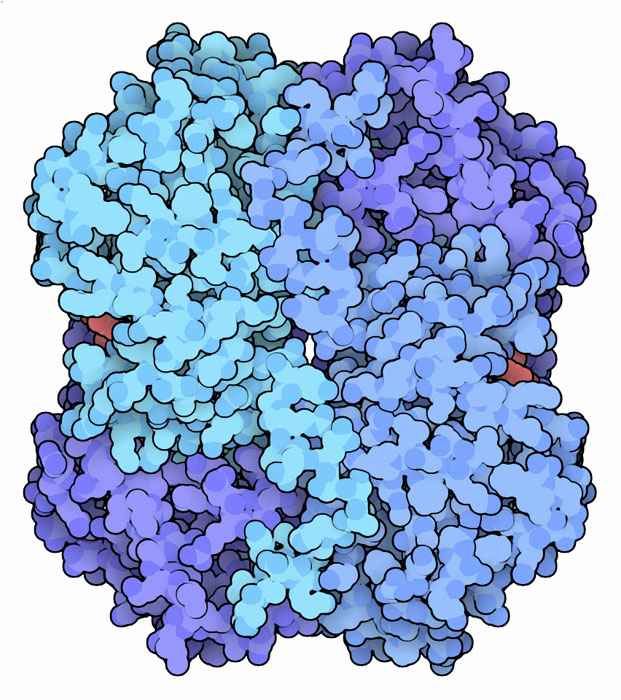|
Inhaltsübersicht | Nanomaschinen | Moleküle | Programme | Kurse | Fun | Links |
||
| > |
Lactate Dehydrogenase
Lactase dehydrogenase is a safety valve in our pipeline of energy production. Most of the time, our cells break down glucose completely, releasing the carbon atoms as carbon dioxide and the hydrogen atoms as water. This requires a lot of oxygen. If the flow of oxygen is not sufficient, however, the pipeline of energy production gets stopped up at the end of glycolysis. Lactate dehydrogenase is the way that cells solve this problem, at least temporarily.
Aerobic exercise
When we exercise at a normal pace, our cells get plenty of oxygen and sugar is broken down quickly and efficiently. However, during sprints or other over-exertions, there isn't enough oxygen to go around. In this case, our cells use glycolysis as their primary source of energy, As part of glycolysis, hydrogen from glucose is placed on NAD+ to form NADH. Normally, these hydrogen atoms are then transferred to oxygen to form water. If oxygen isn't available, the NADH builds up and there isn't enough NAD+ to continue using glycolysis to make ATP. That's where lactate dehydrogenase steps in: it combines pyruvate and NADH, producing lactic acid and NAD+. The NAD+ can then be recycled to do another round of glycolysis, quickly producing more energy for the sprint. However, lactic acid builds up and in a matter of a minute or so, you have to stop and let your body recover. As you catch your breath, your body converts the lactic acid back to pyruvate, where it enters your normal flow of aerobic energy production.
Mix and Match
Our cells build two major types of lactate dehydrogenase: the M form and the H form (there is also a third form that is only made in sperm). These are very similar in size and shape, but they have different catalytic properties. The M form, which is the major form in your large skeletal muscles, is best at converting pyruvate to lactate. It stands ready to get to work if the muscles need to perform anaerobic exercise. The H form, on the other hand, is better at the opposite reaction, converting lactate to pyruvate. It is the major form in the heart, which has a constant supply of oxygen and can easily use lactate as an aerobic source of energy. The two types are so similar in structure that they form complexes with a mixture of both types, for instance, with two H chains and two M chains. In this way, different cells can tailor their lactate dehydrogenases to fit their current needs. The molecule shown here, from PDB entry 3ldh, is the form with four identical M chains.
Next: Fermentation

Last changed by: A.Honegger,